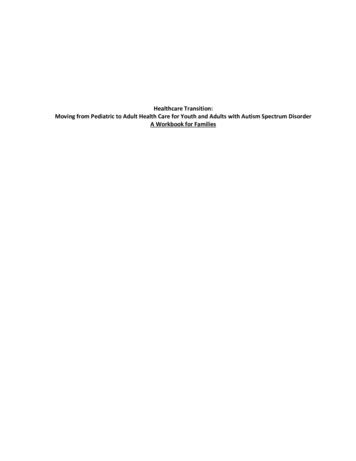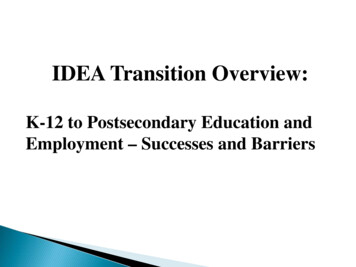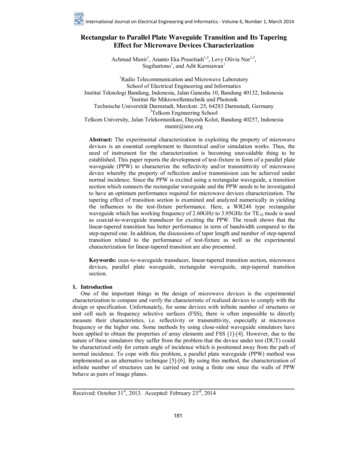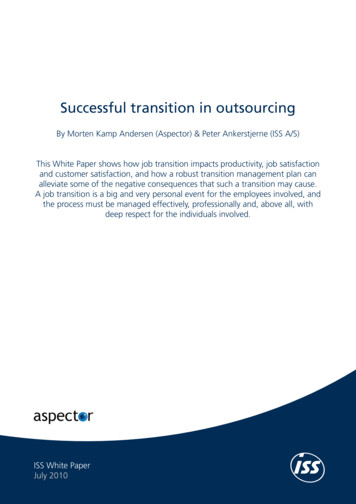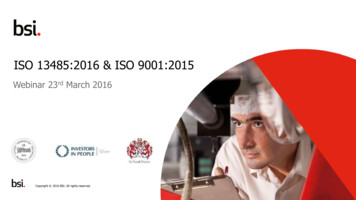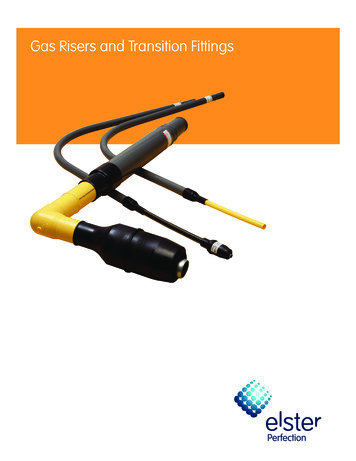
Transcription
The Journal of New Writing in Health and Social CareVolume 2 Issue 2 July 2016The transition to becoming a newly qualified nurse: areflectionRobyn Hardacre and Lesley HayesSchool of Nursing and Midwifery, Faculty of Health Sciences, Staffordshire University.AbstractThis work outlines a piece of reflection that was presented by one individual as part of a level6 undergraduate viva voce assessment, which took place close to the point of qualification.Using a reflective model as a guide, its purpose is to demonstrate and articulate professionaldevelopment in preparation for qualification, and it demonstrates how reflection can be usedto consolidate and identify further development required by the newly qualified nurse.Keywords: newly qualified nurse; preceptorship; professional development; reflection;transitionIntroductionFor a number of years nursing students at Staffordshire University have undertaken thedevelopment of a portfolio of evidence, which has been summatively assessed in year twoand three of their award. This portfolio encompasses evidence that demonstrates the student’sown professional development during their journey towards qualified nurse status. This wideranging evidence includes assessment documents which are completed in practice by mentors,documents to support learning in theory and practice such as SWOTS, action plans andlearning contracts, and reflective writing that facilitates deeper understanding of significantclinical experiences.Students can find the transition stressful (Gerrish 2000, Whitehead and Holmes 2011), andon completion of their award, and having achieved qualified nurse status, can lack confidence(Clarke and Holmes 2007). It has therefore been common for students on the award toconsider, through reflection, the challenges faced by them during this transitional period, inorder to understand the feelings they are experiencing and to identify how they can addressthese in order to successfully prepare themselves for their first nursing role. The reflectionbelow is one such example. It was presented for summative assessment, by one student, aspart of the third year viva, which takes place only a few months prior to qualification. Bowers(2015) whilst focusing on nursing outlines the key purposes of reflection: assisting fusion oftheory and practice and developing critical insight of self and events. The expectation is thatachieving these goals supports planning, personal development and thus achieves a realimprovement in practice. In order to demonstrate the insight and deep learning that can beachieved through reflection, and the personal and professional growth that can arise fromactive engagement with the reflective process, the reflective work is presented below, withonly minor edits being made to enhance the flow of the work. Although this reflection wascompleted prior to the new Nursing and Midwifery Council (NMC) revalidation process beinglaunched it still has resonance and its principles remain intact (NMC 2015a).This is the reflection of one student, and was undertaken for the purpose of personal andprofessional development. Although it could be argued that the opportunities for futurelearning may not be transferrable to other students, it provides insight into the potential ofreflection, in supporting the transition to a newly qualified nurse.32
The Journal of New Writing in Health and Social CareVolume 2 Issue 2 July 2016Transition to Newly Qualified NurseAlthough nursing courses have many stressors and psychological strains (Pulido-Martos,Augusto-Landa and Lopez-Zafra, 2012), this is a small window into the reality shock thatNewly Qualified Nurses (NQNs) face when transitioning from a student to a registered nurse(Stacey, 2010), resulting in high numbers of NQNs leaving in their first year (Health EducationEngland, 2014). To tackle this, I have completed a reflection regarding issues I may face asa NQN, and considerations that I will have to take into account, so I can address these inpractice. I have used the Driscoll and Teh (2001) model of reflection as it is an open reflectionthat does not constrain me to focused questions, but allows me to explore issues in bothbreadth and depth.WHATThere are benefits to supporting NQNs through what can be an extremely challengingtransition for the NQNs, the employer, the patient and the nursing profession (Green, 2014).It is important for the NQNs, as once support offered from their university is cut off, the NQNScan feel isolated and lack confidence (Bjerknes and Bjork, 2012), leading to psychologicalissues such as stress and anxiety, and issues in the workplace, such as reduced workingefficacy, as the NQNs lack the confidence to complete all jobs required, or do so with hesitanceand inefficiency (Maxwell et al, 2011). This lack of support causes many nurses to leave theprofession, leading to high costs for the employer as high turnover requires expenditure forrecruiting and hiring, whilst also being costly for the NHS in the training of nursing students(Twibell, 2012). However, there is also potential benefit arising from limited support. If a NQNis ‘thrown in at the deep end’, this can enhance autonomy and ultimately confidence as therealisation develops that coping is possible (Hollywood, 2011). It can also motivate NQNS toindependently and experientially increase their skills and knowledge meaning these are morelikely to be retained and underpin professional growth (Hollywood, 2011). This ‘survival of thefittest’ proposes that it is emotionally and intellectually capable nurses who remain after thisearly weeding out process (Health Education England, 2014).Regardless, poor support cannot be condoned. It has negative effects on patient care, withpotential to reduce the quality of care or result in harm, due in part to poorly supported NQNsbeing less likely to ask questions or seek advice believing this indicates they are not coping orare not capable (RCN, 2014). This is compounded by NQNs feeling they are not sufficientlytrained and lack sufficient clinical skills at the point of registration, in addition to their perceivedbelief of high expectations for NQNs to be as competent as experienced nurses (Draper, 2013).This can damage the image of the nursing profession, resulting in increases in errors ordecreases in the quality of patient care ultimately reduces the public’s confidence in nursing(Peate, 2012). Yet, NQNs are not sufficiently supported, and have often been the victims ofbullying in circumstances where more experienced nurses may not appreciate staff whorequire additional assistance, or feel that new staff are not good enough (RCN, 2005). Bullyingcan also be from managers, if the NQNs’ values conflict with their own, leading to isolatingalliances and NQNs feeling incompetent (Lowenstein, 2013). This can increase the stress oftransition by creating a toxic environment, reducing morale, confidence, and the NQNs’ senseof value (Tapping, Muir and Marks-Maran, 2013).Whilst trying to find a place within the team and coping with the stresses caused by startingat a new workplace, NQNs also have fear and anxiety caused by the responsibility andaccountability they are given as a registered nurse (Draper, 2013). Nurses must deliverautonomous, competent care and are accountable for the standards of this care, anyomissions, as well as needing to justify decisions made (Scrivener et al, 2011). This requires33
The Journal of New Writing in Health and Social CareVolume 2 Issue 2 July 2016competency in many skills which, often, NQNs are not sufficiently trained in (Draper, Sparrowand Gallagher, 2009). This results in long term issues as NQNs are afraid of making errorsand of having litigation brought against them (Magnusson et al, 2014). Not only is thereapprehension at the point of qualification, it has also been observed that around half waythrough the NQNs’ first year, there is a ‘confidence crisis’, when NQNs become aware of theirlack of competencies which, without support, can cause the NQNs to question their capabilitiesto continue practice (Hole, 2009). However, if sufficient support is provided this can becomea positive experience, with it being used as a motivator to improve competency and patientcare (Miller and Blackman, 2009).Regarding accountability, NQNs need to understand the need to report errors and whistleblow, as it is mandatory for practitioners to raise concerns if they observe anything puttingpatients or others at risk of harm (Whistleblowing Helpline, 2015). However, such lack oftraining and support is a barrier to reporting of errors or whistleblowing, as NQNs are unawareof the correct procedures to follow to protect themselves and their practice, and are hesitantto do so for fear of consequences such as losing their position, bullying and anger frompatients or colleagues (Mathieson, 2013). Regardless of these requirements, NQNs have beenfound to be insufficiently trained to understand accountability, leading to: nurses workingoutside their competencies; poor error reporting; poor time management derived from failureto delegate due to fear of failed accountability; over-checking tasks undertaken by health caresupport workers; reducing work relationships and efficiency (Hall and Ritchie, 2010).Additionally, when having to come to terms with all of these issues of accountability, pooror absent support and a limited skillset, NQNs have additional demands as they must establisha professional portfolio, as it is mandatory for every practitioner to maintain a lifelong, up todate record of their continued professional development (CPD)(Casey and Egan, 2010). Thishas requirements that include at least 35 hours evidenced over three years of relevant,evidence-based learning applicable to practice, with the implementation portrayed (NMC,2010). However, many skills required to conduct meaningful CPD, such as reflection, areadvanced skills that require support, training and experience to develop (Lynch et al, 2009).Additionally, whereas employers previously offered opportunities to continue learning such asstudy days and courses, increasingly the funding for these has been reduced to focus only onmandatory training, greatly reducing the support NQNs gain from the employer (Alsop, 2013).Where wider training opportunities remain other prohibiters continue to have impact; barriersinclude reduced staffing levels where the lack of available staff reduces the ability to covershifts and release nurses to attend study days (Woodward, 2012).SO WHATOne system used to aid transition from student to registered nurse is preceptorship; the useof qualified, experienced nurses to aid the NQNs to settle into their job roles and strengthentheir competencies (Draper, 2013). This is done by providing NQNs lists of required skills, andworking with the NQNs to apply their knowledge on these skills to practice, whilst alsoproviding support and guidance to problem solve and analyse strengths and weaknesses sothese can be addressed (Ripley and Hoad, 2011). Preceptorship started after researchidentified the need to protect nursing by supporting the future workforce (DH, 2010). Althoughit has been reported as equivocal (Currie and Watts, 2012) significant benefits have beenreported and it is an expected part of settling into the registered nurses role. Wherepreceptorship is used, NQNs’ confidence and competence has increased, patient care hasimproved and fewer errors are made (Twibell, 2012). Therefore, DH (2010) suggests thatpreceptorship should be offered to all NQNs, however, access to preceptorship is limited ornon-existent in areas, leading to poor support (Hollywood, 2011). Barriers to preceptorshipinclude confusion of the role of the preceptor, due to lack of knowledge of preceptorship fromthe NQNS’ and lack of formal training for preceptors (Hollywood, 2011). This leads to34
The Journal of New Writing in Health and Social CareVolume 2 Issue 2 July 2016mismatched expectations of help, which increases the feelings of poor support for NQNs(Whitehead, 2001). This effect is also caused if the preceptor is ‘toxic’, in that they use theirposition to disempower or undermine the NQNs. Preceptorship also has barriers in that itrequires time to meet, or complete the paperwork (Whitehead, 2001). However, even withthese barriers, NQNs still feel they benefit (Marks-Maran et al, 2013). There is alsoorganisational ignorance as to the role of preceptorship that has an effect on how effectivelyit is used, evidenced by differing views that argue whether preceptorship should or should notaddress gaps in educational knowledge (DH, 2010). One argument is that it should increasepublic confidence of nurses, however, the opposing view is that staff should already besufficiently trained, and preceptorship should be an aid to applying and increasing skills, notto learn them (Whitehead, 2001). This portrays a lack of definition of the preceptor’s role,which must be addressed so expectations can be standardised and roles clarified (DH, 2010).Another form of organisational support is that of having supernumerary status, in whichNQNs work alongside a peer or mentor, allowing the NQNs to have a role model, so they canknow what is expected of them, whilst giving them time to increase familiarity with policies,documentation and the team, though still allowing them to carry out nursing duties(Tavengwa, 2011). This results in better care as NQNs are supported, can share knowledgeand seek advice, whilst allowing them to begin to apply theory to practice in new situations(Morrell and Ridgway, 2014). This also allows for clinical governance of the NQNs, as they willbe supervised, so areas in need of improvement can be seen (Maguire, 2013). However, forsome NQNs, this can be constraining; nonetheless, for most NQNs this is an invaluableopportunity that facilitates effective transition (Tavengwa, 2011).Preceptorship and supernumerary nursing also has benefits addressing accountabilityissues for NQNs (Ripley and Hoad, 2011). As nurses are accountable for standards of careprovided, preceptorship and supernumerary status allow these to be developed, increasingNQNs’ confidence regarding their competence and aiding them to take responsibility for thecare they provide (Twibell, 2012). Despite this, it is important for NQNs to increase theircompetence individually to meet the standards expected of them, such as knowledge of healthneeds, treatments, holistic care and care delivery (NMC, 2015b). Although learning these willbe aided by support from the workplace, it is the NQN’s responsibility to self-assess theirabilities and improve these as necessary (RCN, 2011a). To achieve this, the NQN requiresknowledge of the set standards, though auditing can help NQNs see if these standards havebeen met (Plant, Pitt and Troke, 2010). Once the nurse is competent, care is safer andstandards higher (Green, Dickerson and Blass, 2010). This learning can be difficult due to timeobligations, however, it is increasingly important as nursing roles change, affecting the skillsexpected of nurses (Handley and Dodge, 2013). Learning can be through various means suchas the use of simulations or information databases, however, learning theory does not alwaysallow the practical application of knowledge and support to develop this is necessary (Benneret al, 2011).For the nurse to be accountable, they also need to be aware of their responsibilities suchas error reporting or whistleblowing, as nurses have a duty of care to prevent foreseeableharm (Mullen, 2014). For this, NQNs need to have awareness of legislation and theexpectations outlined within their Code (NMC, 2015c). If observing something is outside theselaws/standards, the NQN must know how to address this in a professional manner (RMT,2015). This may be by informing a senior member of staff such as a ward manager, so thatthe issue can be dealt with efficiently on a local level, or taking the issue further until it isaddressed (Hole, 2009). Without training and knowledge regarding whistleblowing, effectscan be dire as issues may grow and persist such as in the case leading to the Francis Inquiry(2013). However, NQNs do not have sufficient training, and many do not know that they canask their union for advice or have protection from possible consequences by the publicdisclosure act (RCN, 2011b). This training also extends to the need to know correct errorreporting requirements for NQNs (Covell and Ritchie, 2009). Many NQNs hesitate before35
The Journal of New Writing in Health and Social CareVolume 2 Issue 2 July 2016reporting errors due to the fear of the blame culture in the NHS (Muha, 2014). However, notreporting errors can lead to anxiety and feelings of inadequacy, and prevents errors frombeing tackled systematically (Domrose, 2011). Correct training in error reporting procedurescan assist NQNs to feel supported to admit errors, increasing candour and honesty in theprofession and assisting NQNs to speak up when they notice others make errors, aiding themto advocate for patients (Peate, 2010).To allow nurses to act with the necessary autonomy and accountability, continuingprofessional development (CPD) needs to be utilised to assess competency, maintainevidence-based, up to date knowledge and to identify areas for development (Peate, 2012).This is usually done through the use of a portfolio to establish which CPD learning activitieshave been completed, such as reflections, clinical supervisions or e-learning (Duffy, Dressesand Fulton, 2009). E-learning is increasingly popular as it bypasses barriers of training coursesby being flexible, cheaper and still providing certificates as evidence (Woodward, 2012).However, simply having evidence of learning is not sufficient, NQNs must show how thisknowledge will be implemented to improve practice (HCPC, 2013). The way in which this isundertaken for re-registration with the NMC will from April 2016 be via revalidation which hasthe ultimate aims are ensuring the maintenance of professionalism and patient safety (NMC,2015a).One specific way to improve practice is through reflection, as critical reflection of an eventallows understanding of influencing factors and personal thoughts and feelings (Timmins andDuffy, 2011). However, effective reflection requires time and commitment both of which canact as barriers (Soutter-Green, 2013). Nonetheless there are many benefits to completingreflection; it may identify considerations not previously explored; increase self-awareness;reduce stress; and directly address practice issues (Price and Harrington, 2010). Schonidentified ideas of reflection in action (whilst in practice) and on action (retrospectivelyanalysing practice). Both have relevance with the former being useful by identifying issues asthey occur, giving a sense of what feels right or wrong so that this can be addressed later(Hibberd et al, 2014). Alternatively, the latter whilst potentially being slightly diminished byhaving to recall feelings, allows for calm exploration of an issue so that deep understandingcan be gained (Sharples, 2009). When reflecting, it can be important to incorporate reflectivemodels, as they give reflection depth and purpose, allowing for methodical analysis of anevent (Nuttal, 2013). However, reflection must be completed with caution as NQNs may betoo critical of themselves, so reflection must be balanced regarding positive or negativeattributes (Jasper, Rosser and Mooney, 2013). NQNs can also have a sense of ‘lost innocence’,if issues are found with no solutions, leading reduced confidence and a sense of failure(Bulman and Schutz, 2013). For NQNs, it is essential to know their own limitations, so it canbe accepted that not every issue will have a solution available (Casey and Egan, 2014).Also part of CPD is clinical supervision which is beneficial to NQNs as it offers support andaids to improve competence simultaneously (Fowler, 2013). Clinical supervision can havemany focuses, such as being restorative by exploring concerns, providing some counsellingand improving sense of value for NQNs (Wigens and Heathershaw, 2013); formative, toincrease the skills and competence of the nurse and assist them to self-assess and reflect ontheir capabilities (Lynch et al, 2009), or normative, to improve standards and ensure thatrequirements of their practice are met (Wigens and Heathershaw, 2013). As with reflection,clinical supervision is improved with reflective models, as they give purpose to the supervisionmuch in the way a contract can, by preventing the supervision from becoming a ‘get-together’(Soutter-Green, 2013). The supervisor can empower the NQNs and aid them to understandtheir accomplishments as well as the areas they need to improve (Bond and Holland, 2011).However, NQNs may find clinical supervision difficult as it requires them to be open tochallenging and requires time commitments and preparation, especially if they have littleknowledge as to the benefits of clinical supervision or the use of clinical supervision in CPD(Hollywood, 2011). However, the benefits of clinical supervision have been established by the36
The Journal of New Writing in Health and Social CareVolume 2 Issue 2 July 2016NMC, who state that every nurse should have access to clinical supervision (Chilves andRamsay, 2009), and so it is vital NQNs are shown the benefits, such as reduced stress/anxiety,improved morale and decreased turnover which improving many aspects of healthcare(Cassedy, 2010).NOW WHATAs I am now more aware of the wide-ranging support available and my future responsibilities,I will ease my transition to NQNs by seeking and undertaking a range of opportunities thatwill assist me to develop safe and effective practice. These will include: Seeking support such as preceptorship or supernumerary status to reduce stress oftransition and ensure consolidated and enhanced competency (Hole, 2009). Continuing to remain competent by conducting ongoing learning that is evidencebased to ensure I provide best practice care (Sharples, 2009). Reflecting upon the learning I conduct, to show how it is relevant to the care I provide,as is necessary with CPD (Alsop, 2013). Familiarising myself with legislation relevant to nursing to ensure I work within theboundaries expected of a qualified nurse (RCN, 2014). Establishing a regular supervisor to support and aid in my professional development,with a contract to ensure I get the most out of clinical supervision opportunities(Soutter-Green, 2013).SummaryThis comprehensive reflection utilises a reflective model to support the exploration ofkey issues occurring for one student during the transition to NQN and demonstratesthe key role a reflective model can play in supporting deep reflection and subsequentlearning for novice reflectors (Bowers 2015). The discussion of these issues illustratesboth the complexity and tensions that can be experienced by students undergoing thetransition from student to registered nurse. Grappling with the expectations of a newlyqualified nurse can be challenging, and a reflection with the purpose of identifyingpotential solutions and actions can, as illustrated, help students explore their feelingsaround transition and to build understanding and confidence in relation to these, andthe forthcoming expectations of employers, peers and patients. Subsequently, anaction plan can be created to implement both original and ‘tried and tested’ solutions,allowing the NQN to be prepared in their approaches to the potential barriers theymay face when commencing their first nursing role. This reflection is successful inthese and clearly articulates the need for support such as preceptorship to guide thisprocess.ReferencesAlsop A (2013) Continuing Professional Development in Health and Social Care. (2ndEd. Oxford: Wiley-Blackwell.Benner P, Hooper-Kyriakidis P and Stannard D (2011) Clinical Wisdom andInterventions in Acute and Critical Care: A Thinking-In-Action Approach. (2nd Ed).New York: Springer Publishing Company.37
The Journal of New Writing in Health and Social CareVolume 2 Issue 2 July 2016Bjerknes MS and Bjork IT (2012) Entry into Nursing: An Ethnographic Study ofNewly Qualified Nurses Taking on the Nursing Role in a Hospital Setting. [Online]Available from: http://www.hindawi.com/journals/nrp/2012/690348/. [DateAccessed: 25/02/15].Bond M and Holland S (2011) Skills of Clinical Supervision for Nurses. Glasgow:Open University Press.Bowers S (2015) Bowers Reflective Model. The Journal of New Writing in Health andSocial Care 1. (2) pp 31 - 37. [Online] Available from:http://www.staffs.ac.uk/academic depts/health/research/journal of new writing inhealth and social care issue 2.jsp. [Date Accessed: 25/10/15].Bulman, C and Schutz, S (Eds) (2013) Reflective Practice in Nursing. (5th Ed) Oxford:Wiley-Blackwell.Casey DC and Egan D (2010) The Use of Professional Portfolios and Profiles forCareer Development. British Journal of Community Nursing vol.15, no.11 pp.547 –542.Cassidy, P (2010) First Steps in Clinical Supervision. Glasgow: Open University Press.Chilves R and Ramsey S (2009) Implementing a Clinical Supervision Programme forNurses in a Hospice Setting. International Journal of Palliative Nursing vol.15, no.12,pp.615 – 619.Clark T and Holmes S (2007) Fit for practice? An exploration of the development ofnewly qualified nurses using focus groups. International Journal of Nursing Studiesvol.44, pp.1210 – 1220.Covell CL and Ritchie JA (2009) Nurses Responses to Medication Errors: Suggestionsfor the Development of Organisational Strategies to Improve Reporting. Journal ofNursing Care Quality vol.24, no.4, pp.287 – 297.Currie L and Watts C (2012) Preceptorship and pre-registration nurse education.[Online] Available from:http://www.williscommission.org.uk/ data/assets/pdf file/0011/479936/Preceptorship and pre-registration nurse education.pdf [Date Accessed: 25/10/15].Department of Health (2010) Preceptorship Framework for Newly Registered Nurses,Midwives and Allied Health Professionals. [Online] Available eptorship framework 2010.pdf.[Date Accessed: 25/02/15].Domrose C (2011) Dismantling Nursing’s Catch 22: The Potential Positives of MedError Reporting often are Overshadowed by the Repercussions to Nurses. [Online]Available AL01/108080059#.VO7 aPmsWT8.[Date Accessed: 26/02/15].38
The Journal of New Writing in Health and Social CareVolume 2 Issue 2 July 2016Draper J (2013) Student Nurse’s Experiences of Becoming a Registered Nurse.[Online] Available from: -nurse. [DateAccessed: 25/02/15].Draper J, Sparrow S and Gallagher D (2009) Crossing the Threshold: Students’Experiences of the Transition from Student to Staff Nurse. [Online] Available from:http://oro.open.ac.uk/26544/. [Date Accessed: 25/02/15].Driscoll J and Teh B (2001) The Potential of Reflective Practice to Develop IndividualOrthopaedic Nurse Practitioners and their Practice. Journal of Orthopaedic Nursingvol.5, no.1, pp.95 – 103.Duffy M, Dresses S and Fulton JS (Eds) (2009) Clinical Nurse Specialist Toolkit. NewYork: Springer Publishing Company.Fowler J (2013) Clinical Supervision: From Staff nurse to Nurse Consultant. Part 1:What is Clinical Supervision. British Journal of Nursing vol.22, no.13, p.786.Francis R (2013): The Mid Staffordshire NHS Foundation Trust (2013) Report of theMid Staffordshire NHS Foundation Trust Public Inquiry, Final Report. [Online]Available report [Date Accessed: 25/02/15].Gerrish K (2000) Still fumbling along? A comparative study of the newly qualifiednurse’s perception of the transition from student to qualified nurse. Journal ofAdvanced Nursing vol.32, no.2, pp.473-480.Green, S (2014) Competence and the Nurse New to General Practice. PracticeNursing vol.26, no.1, pp.42 – 45.Green T, Dickerson C and Blas E (2010) Using Competencies and Competence Tollsin Workforce Development. British Journal of Nursing vol.19, no.20, pp.1293 – 1298.Hall C and Ritchie D (2010) What is Nursing? Exeter: Learning Matters Ltd.Handley R and Dodge N (2013) Can Simulated Practice Learning Improve ClinicalCompetence? British Journal of Nursing vol.22, no.9, pp.529 – 535.HCPC (2013) Continuing Professional Development. [Online] Available from:http://www.hpc-uk.org/registrants/cpd/. [Date Accessed: 26/02/15].Health Education England (2014) Growing Nursing Numbers: Literature Review onNurses Leaving the NHS. [Online] Accessed from: .pdf. [Date Accessed: 24/02/15].39
The Journal of New Writing in Health and Social CareVolume 2 Issue 2 July 2016Hibberd JM, Chia SH, Spindler A, Walsh M and Wigginton S (2014) Using ClinicalDecision Making and Reflective Strategies to Support Practice. Journal of ParamedicPractice vol.6, no.5, pp.232 – 235.Hole J (2009) The Newly Qualified Nurse’s Survival Guide. (2nd Ed) Oxford: RadcliffePublishing.Hollywood E (2011) The Lived Experiences of Newly Qualified Children’s Nurses.British Journal of Nursing vol.20, no.11, pp.665 – 671.Jasper M, Rosser M and Mooney G (Eds) (2013) Professional Development,Reflection and Decision Making in Nursing and Healthcare. (2nd Ed) Oxford: WileyBlackwell.Lowenstein LF (2013) Bullying in Nursing and Ways of Dealing with it. [Online]Available from: g-with-it/5056275.article. [DateAccessed: 25/02/15].Lynch L, Hancox K, Happell B and Parker J (2009) Clinical Supervision for Nurses.Oxford: Wiley-Blackwell.Magnusson C, Westwood S, Ball E, Curtis K, Evans K, Horton K, Johnson M and AllanHT (2014) An Investigation in
The Journal of New Writing in Health and Social Care Volume 2 Issue 2 July 2016 33 Transition to Newly Qualified Nurse Although nursing courses have many stressors and psychological strains (Pulido-Martos, Augusto-Landa and Lopez-Zafra, 2012), this is a small window into the reality shock that


